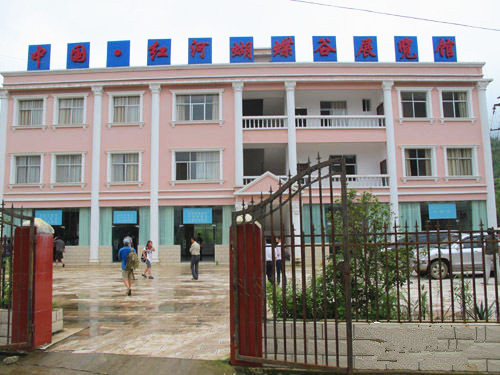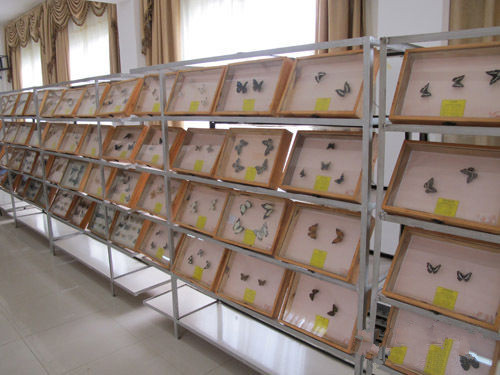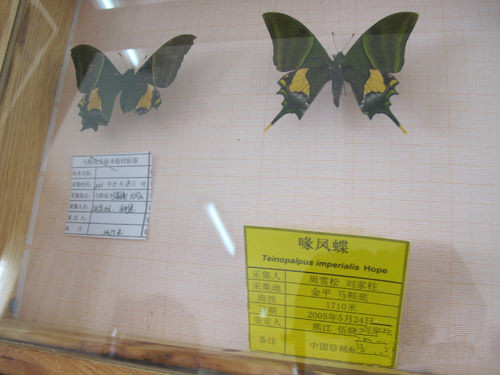 alt="Puer Surrounding Counties and Towns: Weekly & Special Local Markets Travel Guide"
/>
alt="Puer Surrounding Counties and Towns: Weekly & Special Local Markets Travel Guide"
/>
Maandi Butterfly Exhibition Hall in Jinping County, Honghe
Notice: Undefined variable: dst_w in /www/wwwroot/yunnanexploration.com/wp-content/themes/chinatours/inc/aq_resizer.php on line 123
Notice: Undefined variable: dst_h in /www/wwwroot/yunnanexploration.com/wp-content/themes/chinatours/inc/aq_resizer.php on line 123
Overview
The Maandi Butterfly Exhibition Hall (马鞍底蝴蝶展览馆, Mǎ’āndǐ Huǐdié Zhǎnlǎn Guǎn), also known as Maandi Butterfly Valley (马鞍底蝴蝶谷, Mǎ’āndǐ Huǐdié Gǔ), is located in Jinping County (金平县, Jīnpíng Xiàn), Honghe Hani and Yi Autonomous Prefecture (红河哈尼族彝族自治州, Hónghé Hānízú Yízú Zìzhìzhōu), Yunnan Province (云南省, Yúnnán Shěng). The ecological environment here is exceptionally well-preserved, and the butterfly resources are abundant. The local government has established the “China Honghe Butterfly Exhibition Hall” to organize and collect numerous butterfly specimens from the area, promoting ecological awareness and butterfly knowledge. It is a must-visit destination.
In 2005, Professors Liu Jiazhu (刘家柱, Liú Jiāzhù) and Zhou Xuesong (周雪松, Zhōu Xuěsōng) from Southwest Forestry University (西南林业大学, Xīnán Línyè Dàxué) came to Maandi Township (马鞍底乡, Mǎ’āndǐ Xiāng) to investigate and study local ecological and plant resources. They discovered a vast variety of butterfly species and numbers, which initiated research on the local butterfly resources.
Butterfly Diversity
Maandi Valley is home to a diverse range of butterfly species, including:
- Arrow Ring Butterfly (箭环碟, Jiàn Huán Dié)
- Phoenix Eye Butterfly (凤眼碟, Fèngyǎn Dié)
- Dry Leaf Butterfly (枯叶蛱蝶, Kūyè Jiá Dié)
- White-banded Sawtooth Butterfly (白带锯蛱蝶, Bái Dài Jù Jiá Dié)
- Brown-hooked Phoenix Butterfly (褐钩凤蝶, Hè Gōu Fèng Dié)
- Beak Phoenix Butterfly (喙凤蝶, Huì Fèng Dié)
- Purple Ring Butterfly (紫斑环碟, Zǐbān Huán Dié)
- Beautiful Phoenix Butterfly (美凤蝶, Měi Fèng Dié)
Many of these species are rare in China, including the national butterfly, the Chinese Swallowtail Butterfly (中国国蝶, Zhōngguó Guó Dié), the贵凤蝶 (Guì Fèng Dié), and the Brown-hooked Phoenix Butterfly.
Every year, from May to June, thousands of butterflies flutter in the valleys, bamboo forests, and beside streams, creating a rare ecological wonder. The beauty of Maandi Valley is captured in Jin Yong’s (金庸, Jīn Yōng) novel “The Heaven Sword and Dragon Saber” (倚天屠龙记), where there is a stunning valley named “Butterfly Valley,” described as a place where “spring is splendid, and butterflies are everywhere.” In Honghe Prefecture, the sight of billions of butterflies dancing is a real phenomenon.
Global Butterfly Diversity
Globally, approximately 20,000 butterfly species have been documented, with around 2,100 species found in China. The Honghe Butterfly Valley hosts over 320 species, making it one of the richest areas in the world for butterfly populations and diversity, often referred to as the “Butterfly Museum hidden in the mountains.”
Located in Jinping County’s Maandi Township, the Honghe Butterfly Valley enjoys an average annual temperature of about 18°C, with a mild climate and abundant rainfall. The lush bamboo forests covering over 40,000 acres provide ample food sources for butterfly larvae and favorable conditions for their reproduction.
Conservation Efforts
Yang Zhenwen (杨镇文, Yáng Zhènwén), 46 years old, is the director of the Butterfly Valley Museum and a butterfly monitor. For 25 years, he has traversed the mountains, engaged in the protection, investigation, and research of butterfly biodiversity, earning him the affectionate title of “Butterfly Dad” among locals.
According to Yang, “One mountain can have four seasons, and ten miles can bring different weather. This is one of Yunnan’s mountainous regions with a three-dimensional climate.” The original ecological environment and plant diversity within Butterfly Valley provide an excellent biodiversity environment for various butterflies.
Notably, the Gold-spotted Beak Phoenix Butterfly (金斑喙凤蝶, Jīn Bān Huì Fèng Dié) is one of China’s ten rarest butterflies, and the wings of the Golden Phoenix Butterfly (金裳凤蝶, Jīn Cháng Fèng Dié) are large and beautiful.
During the butterfly emergence phase, which occurs in late May to early June, millions of larvae develop into butterflies. Yang mentioned that the Arrow Ring Butterfly will soon enter a concentrated outbreak phase, with swarms of butterflies fluttering through the serene forests, creating a rare ecological spectacle.
The Butterfly Outbreak
The so-called butterfly outbreak refers to the phenomenon where, from May to June each year, the Arrow Ring Butterfly larvae undergo rapid pupation and transformation into butterflies. During this period, billions of Arrow Ring Butterflies gather in the forests, by streams, and along mountain paths, creating a breathtaking biological spectacle.
The occurrence of this butterfly outbreak depends not only on the local ecosystem but also on the careful nurturing by people like Yang Zhenwen, the “Butterfly Dad.” Due to the large butterfly population, many butterflies struggle to find food. They primarily survive on dew and sap, which are insufficient for their growth and development needs.
To support their growth, butterfly researchers and local villagers spent six years developing a nutrient solution made from water, sugar, glutinous rice flour, and pineapple. After emerging from their pupae, butterflies mainly feed on nectar or the juices of decaying matter. During the outbreak, Yang sprays this nutrient solution in the mountains to enhance the butterflies’ nutrition and prolong their lifespan.
Community Involvement
In the 1980s, some locals used pesticides to kill butterflies, but it was later realized that this harmed the ecological environment. Wu Ziweng (吴自文, Wú Zìwén), a villager engaged in butterfly breeding, stated that butterflies are a gift from nature. Through the villagers’ care and protection, the number of butterfly species has increased, and the ecological environment has improved.
Today, the villagers of Maandi have spontaneously formed the Colorful Butterfly Cooperative (七彩蝴蝶专业合作社, Qīcǎi Huǐdié Zhuānyè Hézuòshè), with more and more villagers engaged in butterfly breeding. “Protecting forests, water sources, and butterflies has become a conscious behavior among the locals, written into village regulations,” Yang noted.
“We are enhancing biodiversity protection efforts in our jurisdiction and have established management regulations for the Maandi Butterfly Valley, educating the public on ecological protection awareness,” said Wu Huahao (吴华昊, Wú Huáhào), the deputy secretary of the Jinping County Party Committee and county mayor. In recent years, local authorities have worked to maximize the growth environment and living space for butterflies.
Since opening to the public in 2010, Butterfly Valley has received nearly 1.9 million visitors. The unique butterfly resources have led to special protective measures. Currently, a breeding base with butterfly release gardens, observation areas, and educational facilities has been established, where the story of harmonious coexistence between humans and butterflies continues.
How to Get There
The Maandi Butterfly Exhibition Hall is located in Jinping County and can be accessed through various transportation methods.
Transportation Options
- By Car: Renting a car or hiring a local driver is a convenient way to reach the exhibition hall.
- Public Transport: Local buses and taxis are available for visitors traveling from nearby cities.
Travel Tips
- Best Time to Visit: The ideal time to visit is between May and June during the butterfly outbreak season.
- What to Bring: Comfortable walking shoes, a camera, and insect repellent are recommended for an enjoyable experience.
- Respect the Environment: Always follow local guidelines and respect the natural surroundings during your visit.
- Nearby Attractions: Explore other natural attractions in the area for a more enriching experience.
Visiting the Maandi Butterfly Exhibition Hall offers a unique opportunity to witness the incredible biodiversity of butterflies and appreciate the local ecological efforts in preserving these delicate creatures.



Location:
http://www.hhhdg.cn/index.php?c=article&id=81

 7 Days GolfingTour
7 Days GolfingTour
 8 Days Group Tour
8 Days Group Tour
 8 Days Yunnan Tour
8 Days Yunnan Tour
 7 Days Shangri La Hiking
7 Days Shangri La Hiking
 11 Days Yunnan Tour
11 Days Yunnan Tour
 6 Days Yuanyang Terraces
6 Days Yuanyang Terraces
 11 Days Yunnan Tour
11 Days Yunnan Tour
 8 Days South Yunnan
8 Days South Yunnan
 7 Days Tea Tour
7 Days Tea Tour
 8 Days Muslim Tour
8 Days Muslim Tour
 12 Days Self-Driving
12 Days Self-Driving
 4 Days Haba Climbing
4 Days Haba Climbing
 Tiger Leaping Gorge
Tiger Leaping Gorge
 Stone Forest
Stone Forest
 Yunnan-Tibet
Yunnan-Tibet
 Hani Rice Terraces
Hani Rice Terraces
 Kunming
Kunming
 Lijiang
Lijiang
 Shangri-la
Shangri-la
 Dali
Dali
 XishuangBanna
XishuangBanna
 Honghe
Honghe
 Kunming
Kunming
 Lijiang
Lijiang
 Shangri-la
Shangri-la
 Yuanyang Rice Terraces
Yuanyang Rice Terraces
 Nujiang
Nujiang
 XishuangBanna
XishuangBanna
 Spring City Golf
Spring City Golf
 Snow Mountain Golf
Snow Mountain Golf
 Stone Mountain Golf
Stone Mountain Golf














 What Our Customers Say?
What Our Customers Say?
